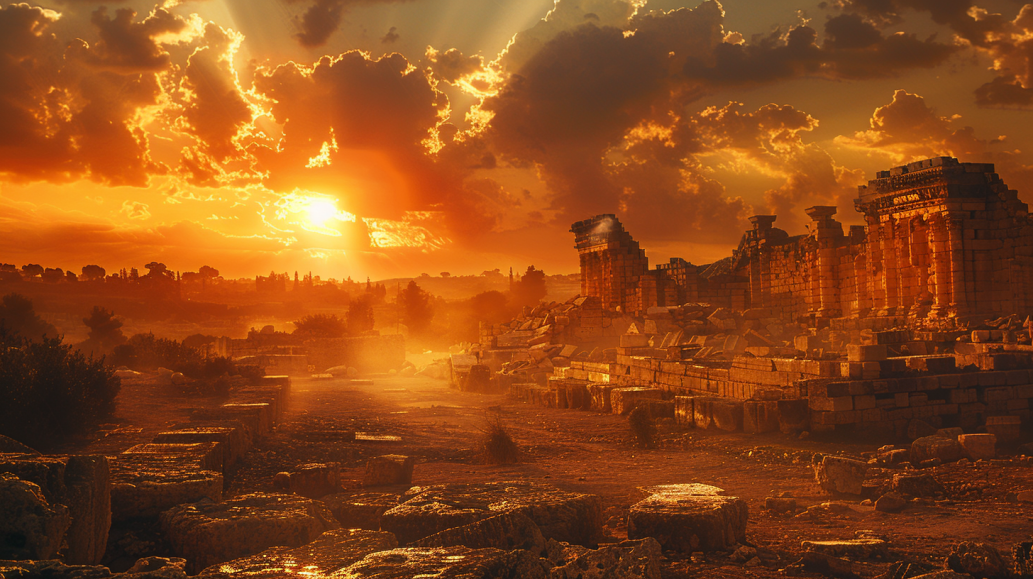Introduction
The ancient city of Armageddon, known biblically as the site of the ultimate battle between good and evil, is more than just a mystical concept. Historically identified with Megiddo, this city was a significant hub in ancient times, situated in what is now modern-day Israel. Its strategic location on the trade route linking Egypt and Mesopotamia made it a focal point for commerce, culture, and conflict. Today, archaeological excavations at Megiddo reveal a rich tapestry of history, yet the full story of its role in biblical prophecy remains elusive.
Geographical and Historical Context
Megiddo is located in the northern part of Israel, in the Jezreel Valley. This site has been continuously inhabited for thousands of years, serving as a crucial point of control over the region’s trade routes. Its geographical position made it a vital city for ancient empires, facilitating trade and military movements between major civilizations.
Biblical References to Armageddon
Armageddon is mentioned in the Bible, particularly in the Book of Revelation, as the site where the final confrontation between the forces of good and evil will occur. This apocalyptic vision has captivated the imagination of theologians, historians, and the general public for centuries. The name “Armageddon” itself is derived from the Hebrew “Har Megiddo,” meaning “Mount of Megiddo.”
Archaeological Discoveries at Megiddo
Archaeologists have been excavating Megiddo since the early 20th century, uncovering numerous layers of settlements. These discoveries include fortifications, temples, palaces, and everyday artifacts that paint a picture of a thriving ancient city. Key findings include a complex water system, storerooms, and stables, highlighting the city’s importance and sophistication.
Layers of Settlements
The site of Megiddo reveals multiple layers of habitation, each representing different periods of its long history. From the Early Bronze Age through the Iron Age, each layer provides insights into the architectural, cultural, and political changes that the city underwent. This stratification makes Megiddo a valuable site for understanding ancient Near Eastern history.
Fortifications and Defensive Structures
Megiddo’s fortifications are among its most impressive features. The city was heavily fortified with walls, gates, and towers designed to withstand attacks. The famous Solomonic gates, attributed to the reign of King Solomon, are an architectural marvel and a testament to the city’s military significance.
Trade and Economy
Megiddo’s strategic location on the trade route known as the Via Maris allowed it to thrive economically. The city served as a major trading hub, facilitating the exchange of goods such as spices, textiles, and precious metals. This economic activity contributed to its wealth and prominence in the ancient world.
Religious and Cultural Aspects
Excavations at Megiddo have uncovered several religious structures, including temples dedicated to various deities. These findings indicate that Megiddo was not only a political and economic center but also a religious one. The presence of artifacts such as figurines and altars provides insights into the spiritual life of its inhabitants.
Theories and Interpretations
Scholars have proposed various theories about Megiddo’s role in history and its connection to biblical prophecies. Some suggest that Megiddo’s repeated destructions and rebuildings symbolize the cyclical nature of conflict and renewal. Others interpret the site as a case study in the interplay between human ambition and divine destiny.
The Final Battle: Fact or Fiction?
The idea of a final apocalyptic battle at Armageddon remains a topic of debate. While some view it as a symbolic representation of the ultimate struggle between good and evil, others consider it a literal event yet to unfold. Historical records do not provide concrete evidence for such a battle occurring at Megiddo, leaving the prophecy open to interpretation.
Megiddo in Modern Research
Modern archaeological techniques continue to shed light on Megiddo’s past. Advances in technology, such as ground-penetrating radar and 3D modeling, allow researchers to explore the site in greater detail. These efforts are uncovering new information about the city’s layout, infrastructure, and daily life.
Public Interest and Tourism
Today, Megiddo is a popular tourist destination, attracting visitors from around the world. The site’s historical and biblical significance, combined with its well-preserved ruins, make it a fascinating place to explore. Tourism has also boosted the local economy and increased awareness of the region’s cultural heritage.
Comparisons with Other Ancient Sites
Megiddo can be compared to other significant biblical and historical sites, such as Jericho and Jerusalem. Each of these cities has a unique history and cultural importance, yet they share common themes of conflict, resilience, and spiritual significance. Megiddo’s distinctiveness lies in its association with the apocalyptic vision of Armageddon.
Preservation and Conservation Efforts
Preserving Megiddo’s archaeological heritage is a challenging task. The site faces threats from natural erosion, urban development, and tourism-related wear and tear. Efforts to protect and conserve Megiddo involve collaboration between international organizations, local authorities, and academic institutions.
Conclusion
The lost biblical city of Armageddon, or Megiddo, continues to captivate the imagination of historians, archaeologists, and the general public. Its rich history, strategic importance, and connection to biblical prophecy make it a site of enduring mystery and significance. As modern research continues to uncover new aspects of Megiddo’s past, the allure of Armageddon remains as powerful as ever.
FAQs
Q: Where is Megiddo located?
A: Megiddo is located in northern Israel, in the Jezreel Valley.
Q: What is the biblical significance of Armageddon?
A: Armageddon is mentioned in the Bible as the prophesied site of the final battle between good and evil.
Q: What have archaeologists discovered at Megiddo?
A: Archaeologists have uncovered layers of settlements, fortifications, temples, and various artifacts.
Q: Is there evidence of a final battle at Megiddo?
A: Historical records do not provide concrete evidence of such a battle, leaving the prophecy open to interpretation.
Q: Why is Megiddo an important archaeological site?
A: Megiddo’s strategic location, historical significance, and rich archaeological findings make it a valuable site for understanding ancient history.

